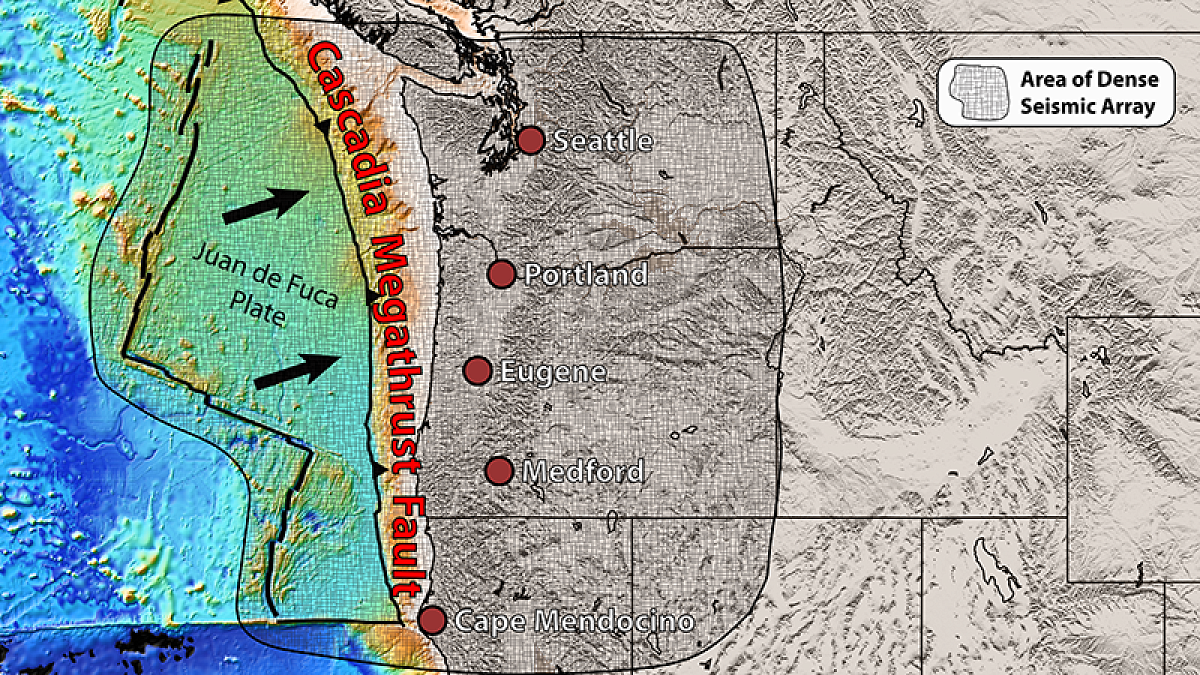UO researchers have found clues from seismic waves that shed new light on the location, frequency and strength of earthquakes along the Cascadia Subduction Zone.
The research, detailed in a paper online in the journal Geophysical Research Letters, doesn’t deliver help for forecasting the next magnitude 9-plus, full-zone rupture of the fault, but it does provide context for the fault’s historical record.
Offshore, but not Cascadia
A series of earthquakes, ranging from magnitude 4.3 to 5.6, struck off the southern Oregon coast, about 124 miles southwest of Gold Beach, early Tuesday morning, July 24.
These events, and others that frequently occur in that area, are not in the Cascadia Subduction Zone.
The area involved is known as the Gorda Deformation Zone, a small plate west of Cascadia caught in a vice between the Pacific and Juan de Fuca plates, said UO seismologist Doug Toomey.
“It is a region of intense deformation and seismicity,” he said.
Earthquakes occurring there are unlikely to cause a tsunami.
The 620-mile subduction zone, which hasn’t had a massive lengthwise earthquake since 1700, is where the Juan de Fuca ocean plate dips under the North American continental plate. The fault stretches just offshore of northern Vancouver Island to Cape Mendocino in northern California.
From a comprehensive analysis of four years of data recorded by 268 seismometers on the ocean floor and several hundred on land, the UO team identified anomalies in the upper mantle below both ends of Cascadia.
The anomalies are regions with lower seismic wave velocities than elsewhere beneath the fault line. They suggest that pieces of the Earth’s upper mantle, just below the crust, are rising and buoyant because of melting rock and possibly elevated temperatures, said UO doctoral student Miles Bodmer, who led a study.
“What we see are these two anomalies that are beneath the subducting slab in the northern and southern parts of the subduction zone,” Bodmer said. “These regions don’t have the same behavior as the entire fault. There are three segments that have their own distinct geological characteristics. The north and south segments have increased locking and increased tremor densities.”
Locking refers to how strongly two plates stick.
“If they are stuck together tightly, as is the case here, they are building up stress and you have the potential for the release of that stress, or energy, in large earthquake events,” Bodmer said.
Such quakes, while strong, are below that projected if Cascadia ruptures all at once, he said. The locking is weaker in Cascadia’s central section, which includes most of Oregon, where infrequent, smaller quakes tend to occur from creeping along the plates.
Tremor refers to long-duration seismic signals often seen at subduction zones.
“These happen deep and take more time than a typical earthquake as they rumble to release energy,” Bodmer said.
The study helps explain long-recognized patterns in Cascadia’s historical record, said co-author Doug Toomey, a seismologist in the UO Department of Earth Sciences.
“Our study is worse news for Portland northward to Seattle and for southern Cascadia, but central Cascadia is not off the hook,” said Toomey, who also is lead investigator for the Oregon component of ShakeAlert, the West Coast early warning network. “More frequent earthquakes to the north and south are seen in historical seismicity patterns.”
The junction of the Cascadia-San Andreas faults, he said, has a lot of complexity and is the most seismically active part of contiguous North America. Seismic history also shows more earthquake activity in the Puget Sound area than in central Oregon. Both regions accumulate energy that eventually is released in large earthquakes, he said.
The study involved deep imaging, similar to CAT scans, using different forms of seismic waves coming from distant earthquakes moving through the Earth.
The ocean-bottom seismic stations, from which data were retrieved every 10 months, were part of the National Science Foundation-funded Cascadia Initiative. Older data from numerous onshore studies in the Western U.S. also were included in the analysis.
The anomalies, Bodmer said, suggest that the buoyant ends serve to modulate plate coupling forces. The findings, he added, could apply to subduction zones elsewhere.
“Knowing the timing and path of the seismic signals, we can look at velocity variation and equate that to the structures,” he said. “With large offshore data sources, we might be able to better understand how a large rupture in the south might extend into Central Oregon.”
Moving forward, Toomey said, there is a need for real-time, onshore-offshore seismic monitoring and geodetic analyses, such as from GPS, to help plot spatial coordinates. That, he added, could feed efforts to project earthquakes in the fault zone.
Co-authors on the study – “Buoyant Asthenosphere Beneath Cascadia Influences Megathrust Segmentation” – were Emilie Hooft, a professor in the UO Department of Earth Sciences, and Brandon Schmandt, a professor at the University of New Mexico who earned his doctorate from the UO in 2011.
The study's publication quickly drew coverage from Temblor, a website dedicated to earthquake research, in the story: “New findings clarify the seismic risk in the Pacific Northwest.”
—By Jim Barlow, University Communications


